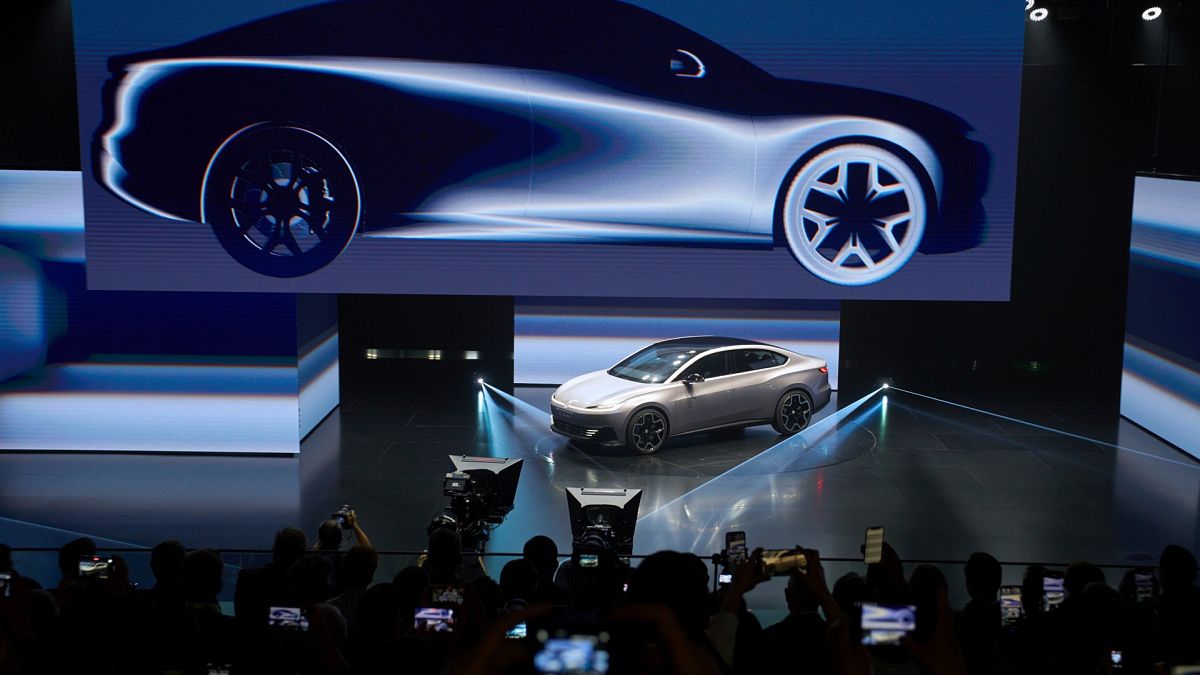Leading automakers will be showcasing their latest designed-for-China models at the Shanghai auto show this week – in a bid to stay competitive in the world’s largest car market.
Some industry experts view this year’s show in the sprawling industrial outskirts of Shanghai as a tipping point. Three decades after Beijing set out to build a world-class car industry, local manufacturers account for about two-thirds of sales inside China, and a growing share of global exports.
The exhibition opens to the public on Thursday and runs until 2 May.
Increased demand for EVs
Encouraged by government subsidies for scrapping older cars for the latest models, Chinese drivers have embraced the switch to electric vehicles (EVs), with sales of battery-powered and hybrid vehicles jumping 40% last year.
A total of 31.4 million vehicles including buses and trucks were sold last year in the world’s biggest market by sales, up 4.5% compared to a year earlier, the China Association of Automobile Manufacturers reported.
Growth in sales of EVs was offset by falling sales of traditional gasoline and diesel-powered vehicles, which still accounted for just over half of new car sales.
Chinese electric vehicle maker BY nudged past Tesla as the world’s biggest maker of EVs by sales last year, reporting revenue of over $100 billion (€87.8bn). It recently announced an ultra fast EV charging system that it says can provide a full charge for its latest EVs within five to eight minutes, about the time needed to fill up at the pump. It plans to build more than 4,000 of the new charging stations across China.
Survival of the fittest
To gain access to China’s potentially huge market, foreign automakers like Volkswagen, General Motors, BMW and Ford set up joint ventures with state-owned local companies beginning in the 1980s and 90s, helping them build the capacity and technology to compete on a world scale.
They also created sprawling supply chains in Shanghai and other major manufacturing hubs, helping to nurture other big names in the Chinese car industry, such as BYD, Geely and Great Wall Motors.
Facing brutal competition at home, Chinese carmakers are expanding rapidly into many world markets, winning market share with relatively affordable sedans, SUVs and pickup trucks.
Shanghai’s auto show is a gathering for the “survival of the fittest,” Zhou Lijun, director and chief researcher of the industry analysis group Yiche Research Institute, said. It’s also a turning point in that local automakers have switched from a supporting role to being the real protagonists on the world stage, he added.
That doesn’t mean all the EV makers go it alone. BYD teamed up with Daimler, now the Mercedes-Benz Group, to launch its Denza premium brand, featured on billboards in Southeast Asian capitals like Bangkok.
Tariffs and other challenges
Opening markets wider to foreign competition has given car buyers a choice of more affordable, innovative vehicles. But that has been a mixed blessing for older automakers like GM, Ford, Toyota and VW that now face fiercer competition both at home and abroad.
Trump doubled down on tariffs on Chinese goods, raising them to up to 145%. His recent announcement of a 90-day pause temporarily spared many other countries including Japan from 24% across-the-board tariffs. But a 10% baseline tariff and a 25% tax on imported cars, auto parts, steel and aluminium exports remains in place.
Higher US and European tariffs on foreign-made EVs are prompting Chinese newcomers to shift production closer to those markets as more Western consumers opt for the latest Chinese models.
Not that long ago, Japanese automakers were doing the same, as they fought trade friction with the United States over their own exports. Now, Toyota, Honda and Nissan employ hundreds of thousands of US workers at their US factories.
“The trade war between China and the United States has blocked direct exports from China to the United States, but it hasn’t blocked local production there or the establishment of global production bases in Europe or elsewhere,” Zhou said.
But as Trump’s 25% tariffs on foreign-made vehicles shows, other factors may slow that expansion.
A report by the Rhodium Group shows that nearly half the world’s markets are restricting imports from China, in part because of national security concerns linked to the advanced electronics in EVs and other high-tech vehicles.
About 12% of the global market is relatively open, including countries like Australia and South Africa. According to the report, Russia is a major market but is nearly saturated.
The road ahead
Chinese automakers lag behind global leaders like Toyota in conventional gasoline and diesel fuelled vehicles, but they can sell EVs at roughly the same price, while also solving the problems of range and fast charging.
China has become part of what geopolitical analyst Yanmei Xie described, in a commentary in the Japanese financial publication Nikkei Asia, as a “technological paradigm shift.”
Automakers in China are going electric not just because of the green transition, but as a route to “technological and industrial dominance,” she wrote.
EV makers in China have benefited from not having huge legacy operations that have to make the transition, Stefan Sielaff, vice president of global design for EV maker Zeekr Group, part of Geely’s stable of brands. Founded in 2021, it’s selling cars in more than 80 markets including in Europe.
“Therefore they can immediately react to market demand, to customer demand, and can deliver very, very fast,” he said.

